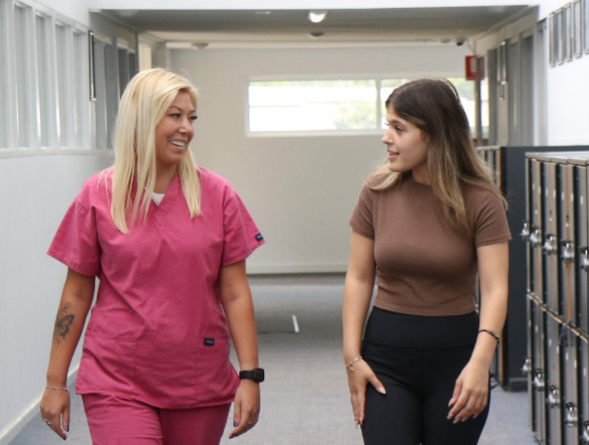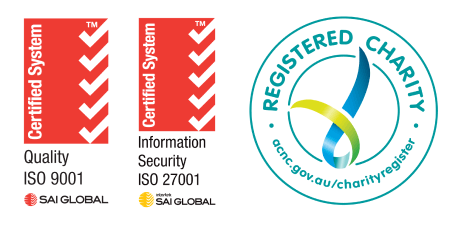
Image credit: The Health Advocate – Nurse Priscilla Javni and year 12 student Angelina Trifunoski
This article first appeared in The Health Advocate published on 5 May 2022.
Written by Andrew Masterson, Communications and Media Adviser, NWMPHN
Dr Jenni Lyne sits at a table in the medical centre at Reservoir High School.
‘I’ve only been doing this for a couple of months, but I think from the different variety of presentations that I’ve seen so far, to me it seems like a good idea to have doctors in secondary schools,’ she reflects.
‘Access to health care can be very difficult for young people. They are at school when clinics are open – many of which don’t have after hours appointments. And if they do manage to book a time outside of school hours, getting themselves physically there can be challenging.’
Dr Lyne is part of a Doctors in Secondary Schools (DiSS) team. She works part-time at two clinics – Reservoir Medical Group, and IPC Health in Deer Park. She spends one day a week at the local high school as an extension of the first residency, and another at Laverton College P-12 as part of the second.
The work, she says, adds an extra dimension to her professional life as a GP.
‘The main benefit to me with these roles is really just being able to feel like you are providing a service that is of need,’ she says.
‘A lot of these young people don’t normally access health care – or don’t even realise that they need to access health care until you start asking all the questions.’
Doctors in Secondary Schools is a program funded by the Victorian Government’s Department of Education and Training and administered through Primary Health Networks. Running since 2017, it seeks to place a GP and a nurse on campus for one day every week during term time at 100 schools in the state’s most under-resourced metropolitan and regional areas.
The program has been a significant success, but it is not without its challenges.
Working with young people as they emerge from childhood into adulthood is rewarding, DiSS participants agree. Practices are expected to sign up to the project for a year, but most stay for at least two.
Nevertheless, from time to time vacancies arise. For this reason, the North Western Melbourne Primary Health Network (NWMPHN) – the lead agency in the DiSS project – has kicked off a rolling Expressions of Interest scheme, inviting eligible general practices to register their availability, ahead of possible opportunities.
‘It’s an important matter of equity and access to medical care,’ explains NWMPHN’s Marie-Louise Neary, who heads the recruitment drive.
‘Many families are under significant pressure and for a variety of reasons sometimes this makes it difficult for young people to get the attention they need. Missing out on care has lots of knock-on effects, not only for health but also for education and social connection.’
And sometimes, even with parents happy and willing to ferry a young people to a medical clinic, having access to care on campus is still the best option.
‘It gives them the opportunity to come and see us confidentially,’ says Priscilla Javni, a nurse at Reservoir Medical Group who does DiSS duty with Dr Lyne.
‘A lot of the problems they are having are school problems, or they might be home problems, but in either case they are things they need to talk about but they don’t want their parents knowing.’
(Teenagers have certain age-dependent legal rights around health care and confidentiality; DiSS personnel, as well as school principals, fulltime school nurses and wellbeing officers, are trained to navigate and respect these.)
Andrew McNeil, Principal at Reservoir High, is quick to acknowledge the value of the program.
‘It provides a safe space for our students to see the doctor,’ he says. ‘Our students are very comfortable at school. It is something they are very familiar with. They don’t have to go to a new clinic. They don’t have to do anything different.’
It’s interesting, though, that doing something different is a prime motivation for some GPs and nurses to enrol in DiSS.
Dr Hannah Walker, for example, provides DiSS care at Mt Rowan Secondary School in the Victorian regional city of Ballarat.
She decided to join the project in 2021 – in part, to keep her own professional life fresh.
‘I wanted to keep my practice varied,’ she says. ‘I wanted to challenge myself and do something different to my specialty – which is palliative care.’
‘I’m a GP at UFS Medical in Ballarat. I think you can be very cushioned in your exposure to the community, so it’s important to expose yourself to different environments. To keep going, you have to push yourself and change things around.’
General practices interested in exploring the Doctors in Secondary Schools program can check out the online expression of interest form here.






